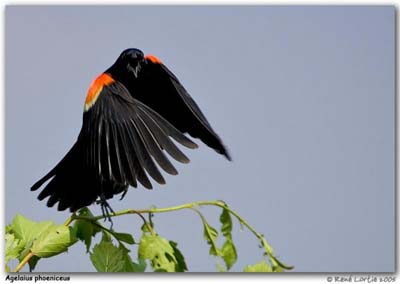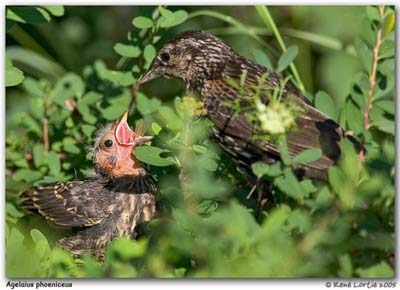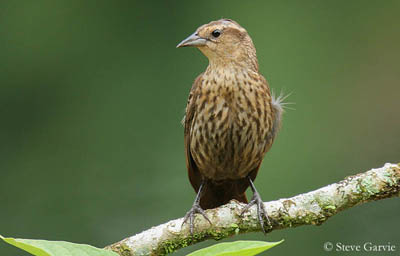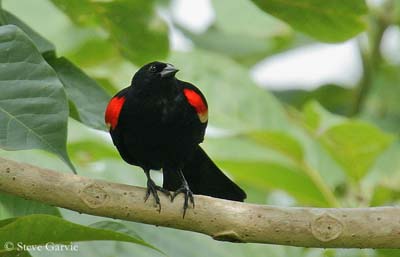
Red-winged Blackbird
Agelaius phoeniceus
Passeriforme Order - Icteridae Family
BIOMETRICS:
Length: 17-23 cm; Wingspan: 31-40 cm; Weight: 32-77 g
LONGEVITY: up to 16 years
DESCRIPTION:
Red-winged Blackbird male has glossy black plumage, with conspicuous orange red shoulders patches, bordered below by narrow yellow edge.
Female is brown on the upperparts, and has heavily streaked underparts. On the head, she has a pale eyebrow. She may have a pinkish tinge on chin and throat, and there is a trace of the male’s coloured shoulders.
Both sexes have sharp, pointed, conical bill. Legs, claws, eyes and bill are blackish.
Immature male looks like adult female, but darker, with an orange shoulder patch bordered with white.
Immature female looks like adult female.
HABITAT:
Red-winged Blackbird nests in thick vegetation, in freshwater marshes, wetlands and grassy areas. It forages in surrounding fields, orchards and in open patches in woodlands.
RANGE:
Red-winged Blackbird breeds from SE Alaska across Canada and United States, and southwards to Central America.
It winters from S Canada, British Columbia, S Ontario and Nova Scotia, and southwards to Costa Rica.
BEHAVIOUR:
Red-winged Blackbird is almost the terrestrial bird more widespread in North America. It is an active feeder. It gleans insects and seeds on ground and in vegetation. It hawks insects in the air. Red-winged Blackbird feeds that it finds. It also uses the bill for “gaping”, to open up crevices in plants to extract invertebrates. It forages on the ground, but also in shrubs and trees.
During the breeding season, it feeds mainly on insects, and during the winter, it feeds rather on grains, in large flocks.
Red-winged Blackbird has a bill with varied uses, to open a seed, to snatch a fly, to spear a beetle or to crack open an acorn.
REPRODUCTION:
Red-winged Blackbird’s nest is often situated in wetland or agricultural areas. Female chooses the nest site, and male performs a nesting display, that it will be its main work in the process.
Nest is made with cattail stalks woven together, forming well made cup above water level, at about 1 metre to 2,50 metres high. It is lined with soft and fine materials. Nest is attached to growing marsh vegetation.
DIET:
Red-winged Blackbird feeds mainly on seeds, but also insects, spiders, molluscs, worms, mussels, snails, crayfish, frogs, lizards, bird eggs and nestlings. They also consume some fruit and berries.
PROTECTION / THREATS / STATUS:
Red-winged Blackbird is considered as pest because it feeds on grain in cultivated fields, but farmers benefit because it consumes harmful insects during nesting season.
These birds are very common in appropriate habitat. Populations have increased greatly during the last century. It is one of the most common and widespread bird in North America.
Fr: Carouge à épaulettes
All : Rotschulterstärling
Esp : Turpial Sargento
It : Ittero alirosse
Nd : Epauletspreeuw
Sd : Rödvingetrupial
Photographs by Steve Garvie
His website :
RAINBIRDER Photo galleries
Photographs by René Lortie
His website : http://rlortie.ca/
Text by Nicole Bouglouan
Sources:
FIELD GUIDE TO THE BIRDS OF NORTH AMERICA - National Geographic Society - ISBN: 0792274512
THE HANDBOOK OF BIRD IDENTIFICATION FOR EUROPE AND THE WESTERN PALEARCTIC by Mark Beaman, Steve Madge - C.Helm - ISBN: 0713639601
NEW WORLD BLACKBIRDS – THE ICTERIDS by Alvaro Jaramillo and Peter Burke – Helm - ISBN : 0713643331
All About Birds (Cornell Lab of Ornithology)
Animal Diversity Web (University of Michigan Museum of Zoology)
Birds of Nova Scotia (Robie Tufts)

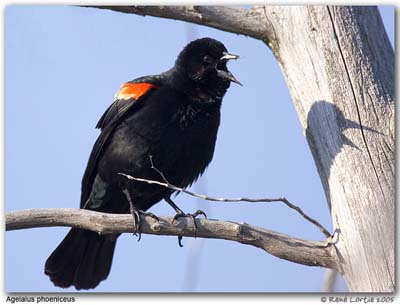
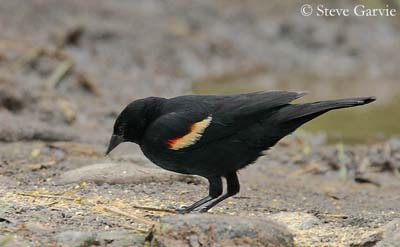
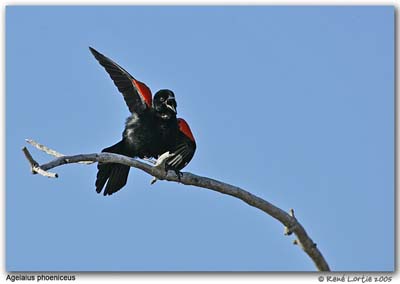
Males defend their territories surveying from a high perch, and flying after intruders, displaying their red wing-patches. They may attack horses and people.
However, Red-winged Blackbird is gregarious, sharing winter roosts with other species, forming huge congregations of several millions birds.
FLIGHT:
Red-winged Blackbird is able to fly at up to 48 km per hour. They have an up and down flight pattern. It is a strong flier, migrating in large flocks, and travelling great distances between roosting and foraging areas each day.
